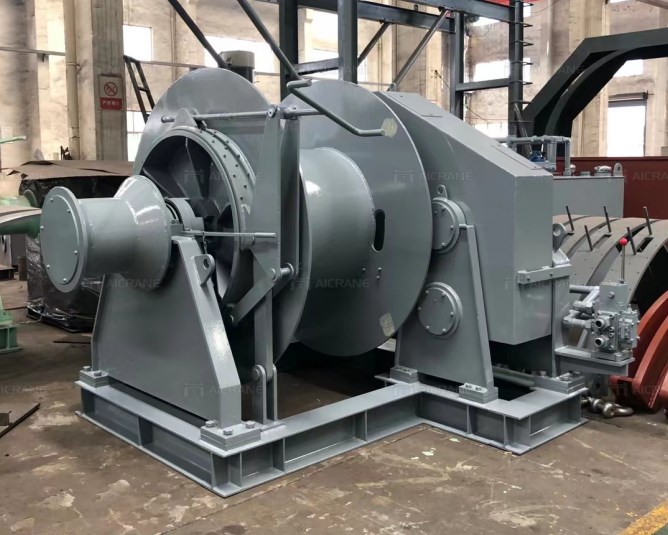Learn About the Marine Hydraulic Towing Winch Systems
In the vast expanse of the maritime industry, towing operations play a crucial role in ensuring the safe movement of vessels, salvaging distressed ships, and supporting offshore activities. At the heart of these operations lies the marine hydraulic towing winch system, a sophisticated assembly that combines hydraulic power, mechanical engineering, and precise control mechanisms. This article delves into the intricacies of marine hydraulic towing winch systems, exploring their components, working principles, and operational significance.
Components of Marine Hydraulic Towing Winch Systems
A marine hydraulic towing winch system is a complex arrangement of interconnected components designed to exert controlled force, enabling the movement of other vessels or objects. The primary components include:
Hydraulic Power Unit (HPU): The HPU serves as the heart of the system. It consists of a hydraulic pump, reservoir, filters, and controls. The pump pressurizes hydraulic fluid, which is then directed to various components to initiate and regulate the towing process.
Hydraulic Motor: The hydraulic motor converts the pressurized hydraulic fluid's energy into rotational mechanical power. This power drives the winching mechanism, allowing for controlled winding and unwinding of the towing line.
Winch Drum: The winch drum is a cylindrical spool around which the towing line is wound. The drum's rotation is powered by the hydraulic motor. It facilitates the controlled deployment and retrieval of the towing line during operations.
Towing Line: The towing line is a high-strength cable or rope that connects the towing vessel to the vessel being towed. It transmits the force generated by the winch to the object being moved.
Control System: The control system comprises valves, switches, and control panels that regulate the flow of hydraulic fluid to the hydraulic motor. This system allows operators to control the speed, direction, and tension of the towing line.
Braking Mechanism: A braking mechanism ensures that the winch drum remains stationary when needed. This prevents unintentional movement and provides better control over the towing process.
Working Principles of Marine Hydraulic Towing Winch Systems
The working of a marine hydraulic towing winch system can be summarized in the following steps:
Hydraulic Fluid Pressurization: The hydraulic pump pressurizes hydraulic fluid within the HPU, creating potential energy that will be converted into mechanical power.
Fluid Transfer to Hydraulic Motor: The pressurized hydraulic fluid is directed to the hydraulic motor, initiating its rotation. The hydraulic motor converts the fluid's energy into rotational force.
Rotation of Winch Drum: The rotational force of the hydraulic motor is transferred to the winch drum through a gear mechanism. The drum starts to rotate, winding or unwinding the towing line based on the direction of rotation.
Deployment or Retrieval of Towing Line: As the drum rotates, it either deploys the towing line to extend its length or retrieves it to pull the object being towed closer. The speed and tension of this process are controlled by the operator using the control system.
Controlled Force Transmission: The tension in the towing line exerts a controlled force on the object being towed, allowing for safe and precise movement. The operator adjusts the tension to ensure the towing process remains controlled and steady.
Operational Significance
Marine hydraulic towing winch systems hold significant operational importance for the maritime industry:
Safety and Control: Hydraulic systems provide precise control over force and speed, allowing operators to maneuver with accuracy and minimize risks during towing operations.
Versatility: These winch systems can handle a variety of towing tasks, from maneuvering large vessels to assisting in salvage and offshore operations.
Efficiency: The mechanical advantage of hydraulic systems enables them to exert substantial force while maintaining efficiency, crucial for handling heavy loads.
Remote Operation: Many modern hydraulic winch systems can be operated remotely, enhancing operator safety and facilitating operations in challenging conditions.
Adaptability: Marine hydraulic towing winch systems can be tailored to suit specific vessel and operational requirements, making them versatile tools for various maritime tasks.
Conclusion
The marine hydraulic towing winch system stands as a testament to the marriage of hydraulic power and mechanical engineering in the maritime world. With a harmonious blend of components, intricate working principles, and a focus on precision, these systems ensure the seamless movement of vessels and objects across the open seas. As the maritime industry continues to evolve, marine hydraulic towing winch systems will remain at the forefront of safe and efficient towing operations, enabling vessels to navigate with confidence and control.



Comments
Post a Comment